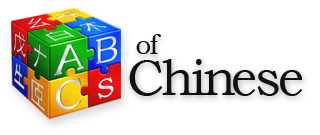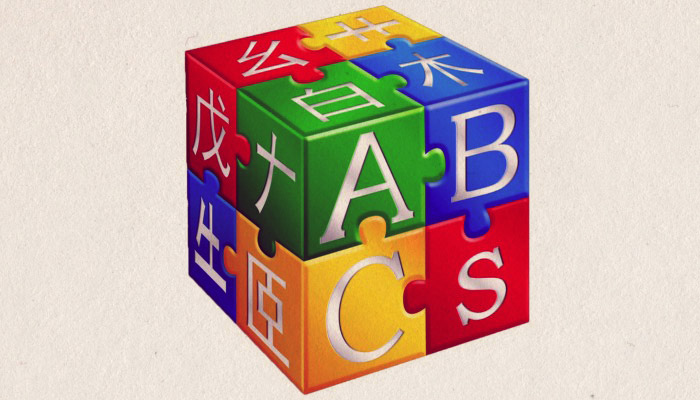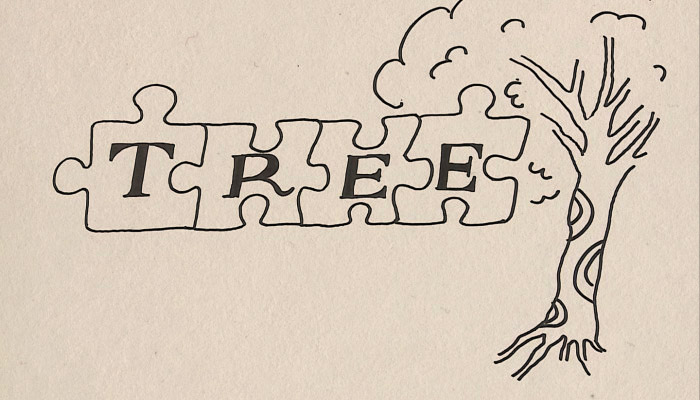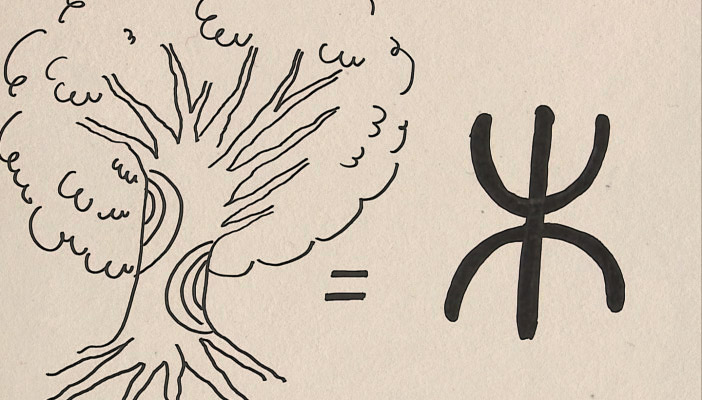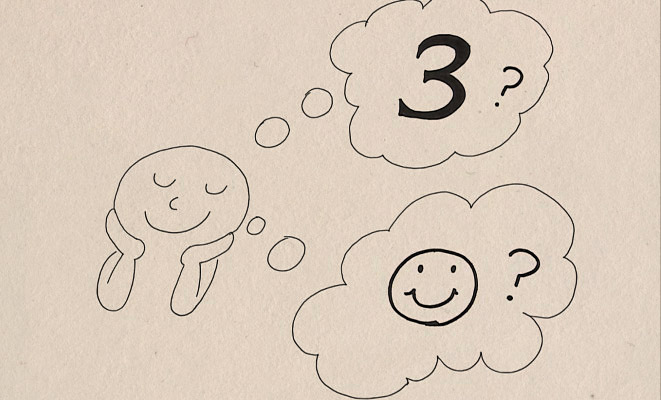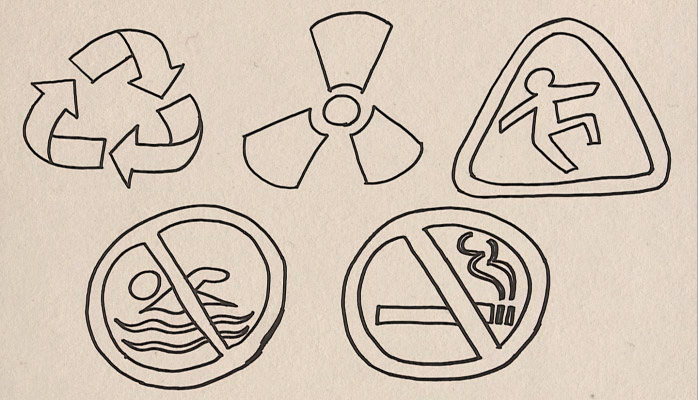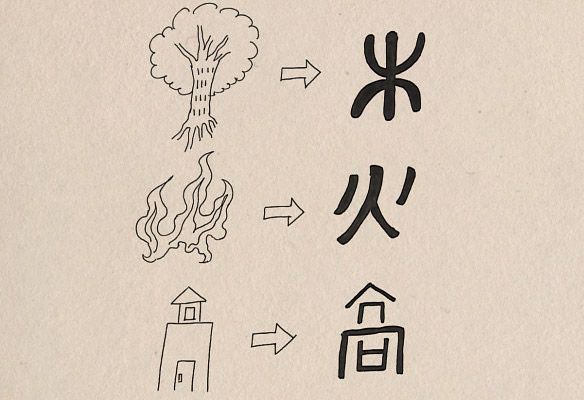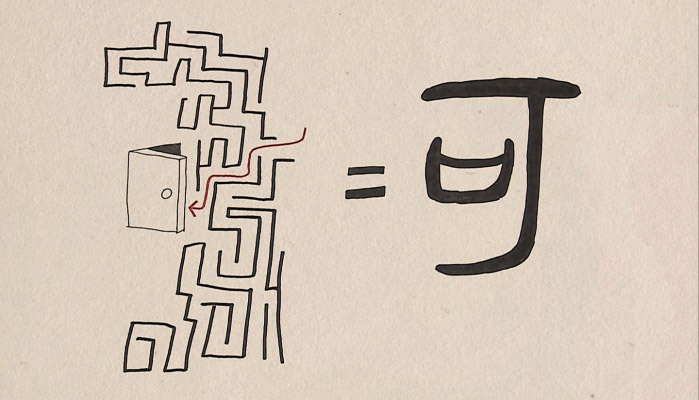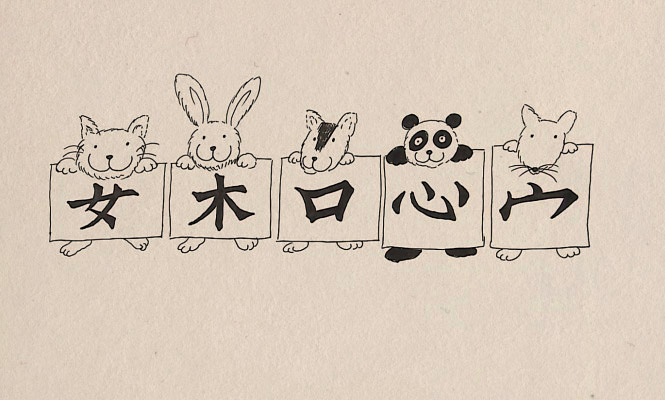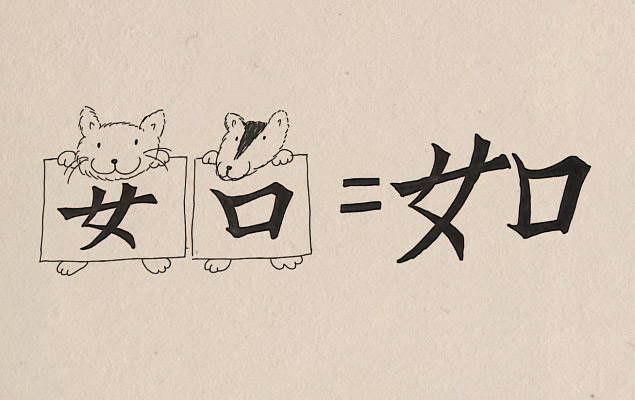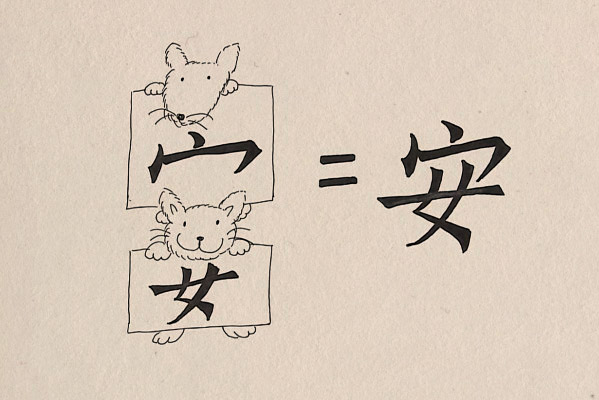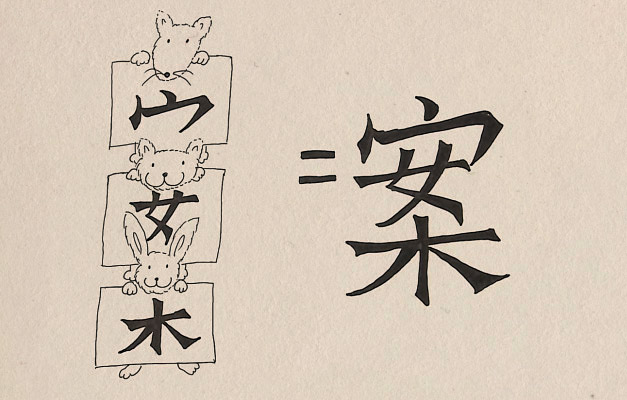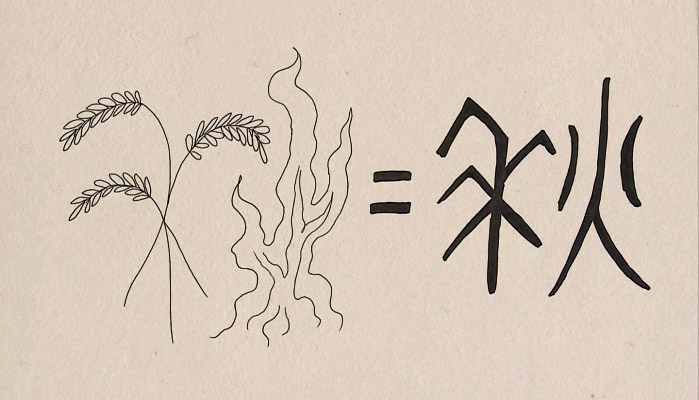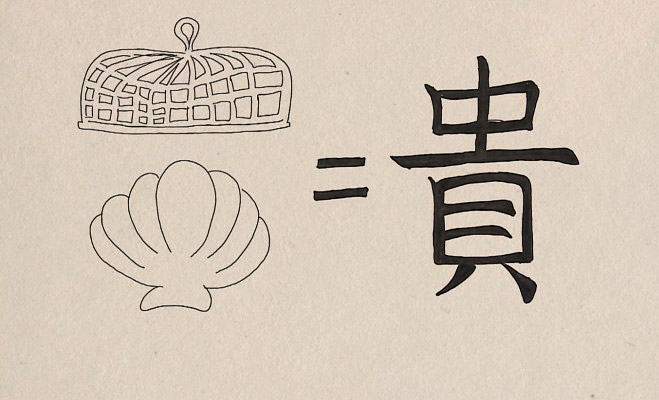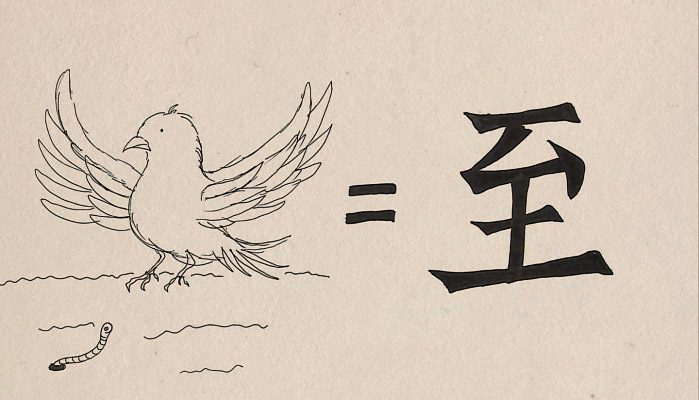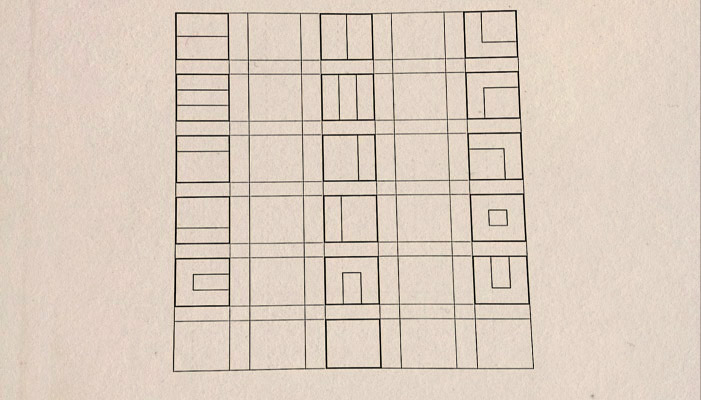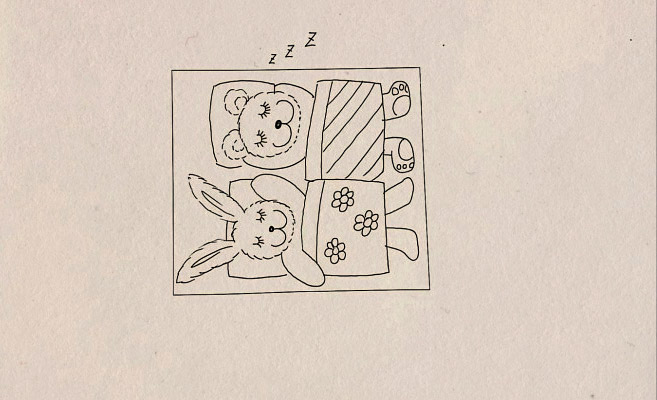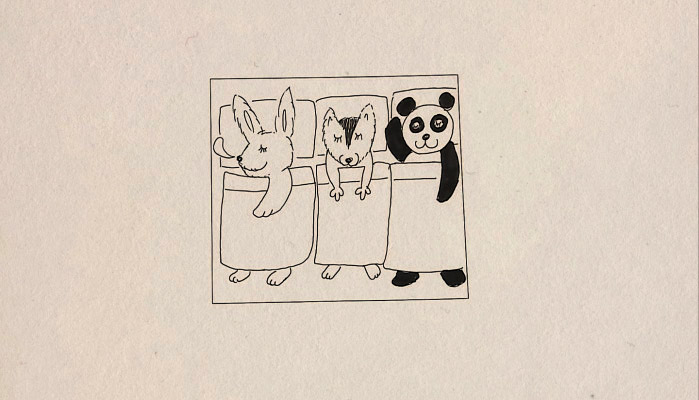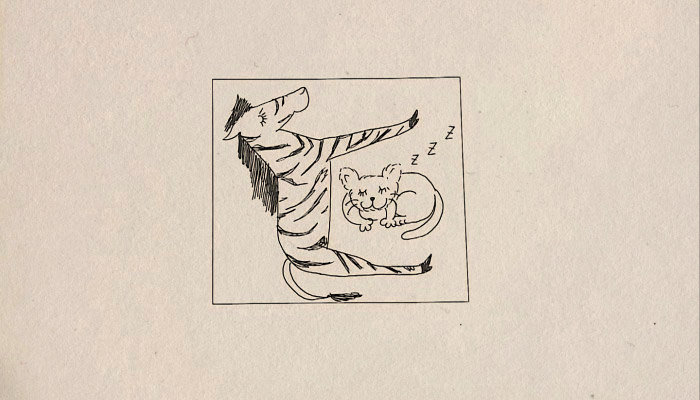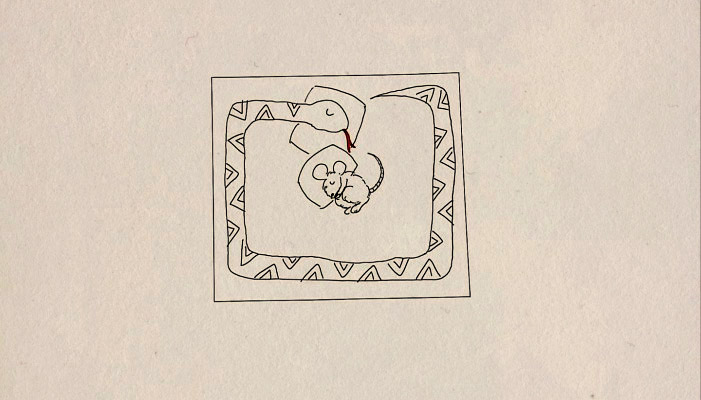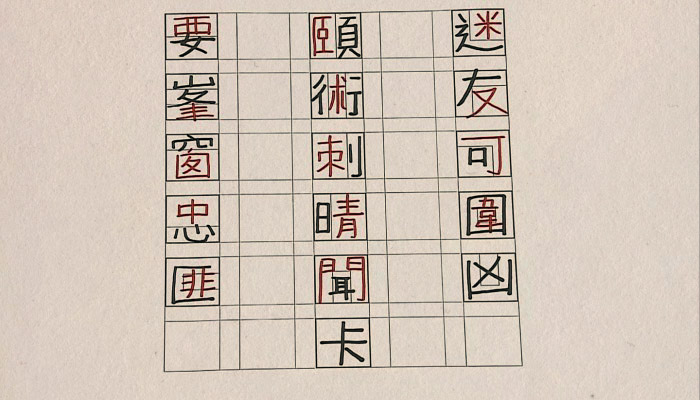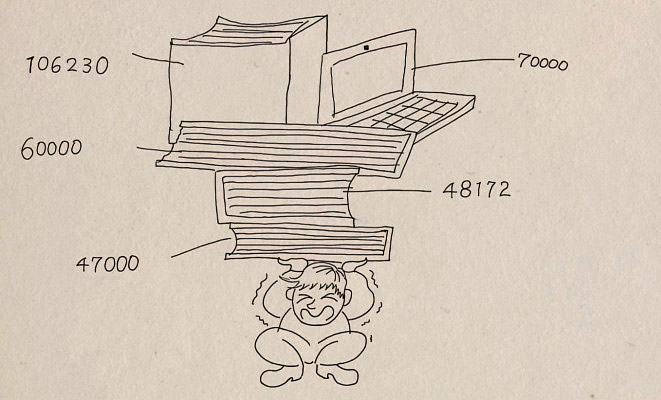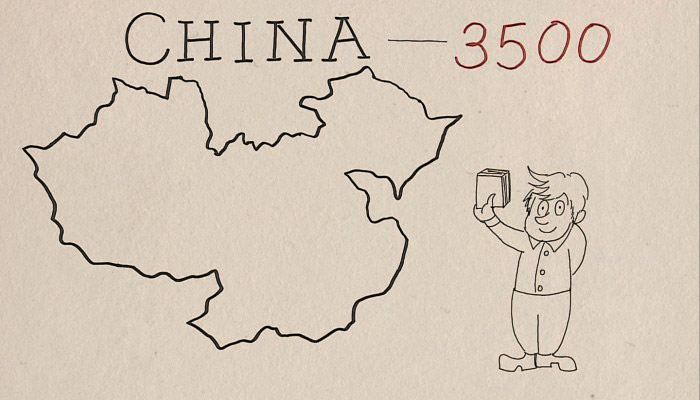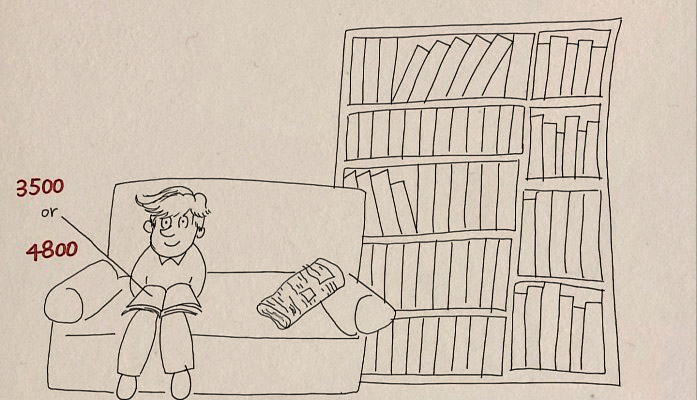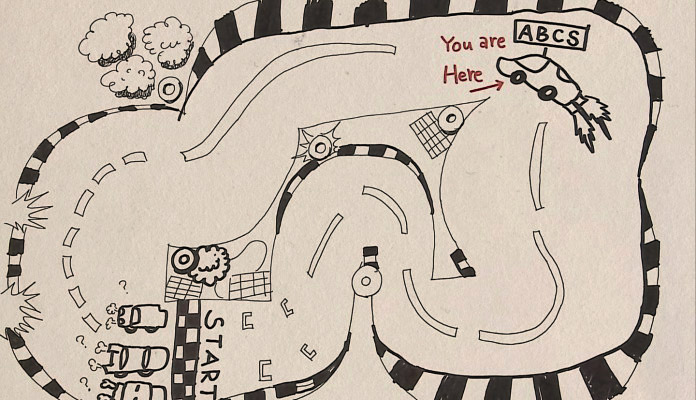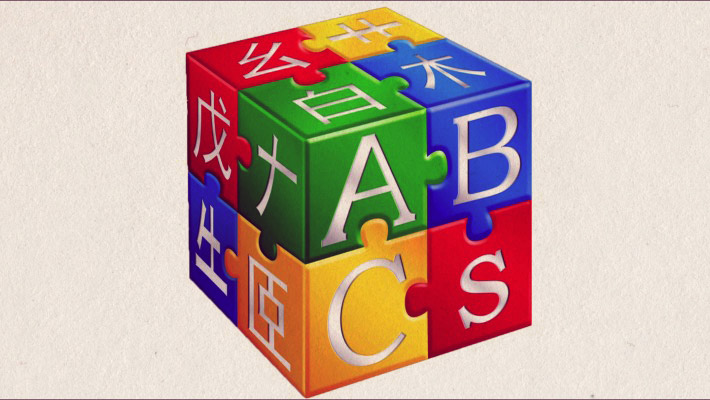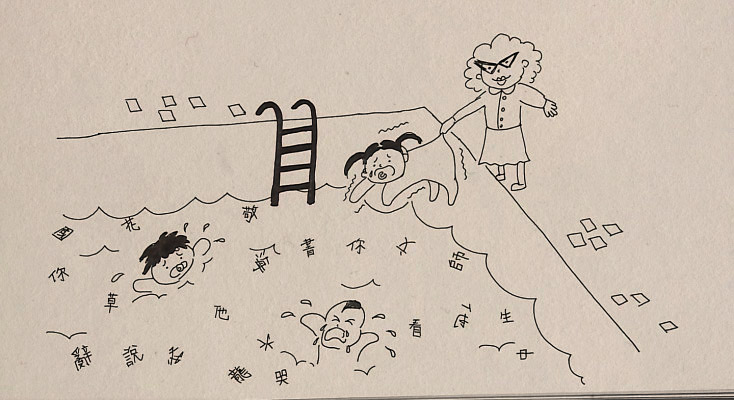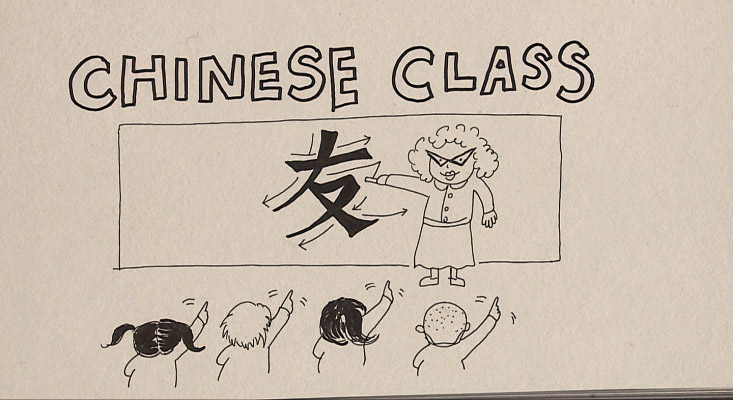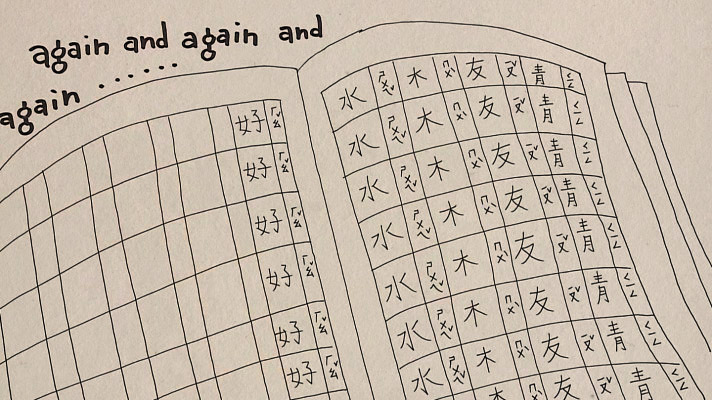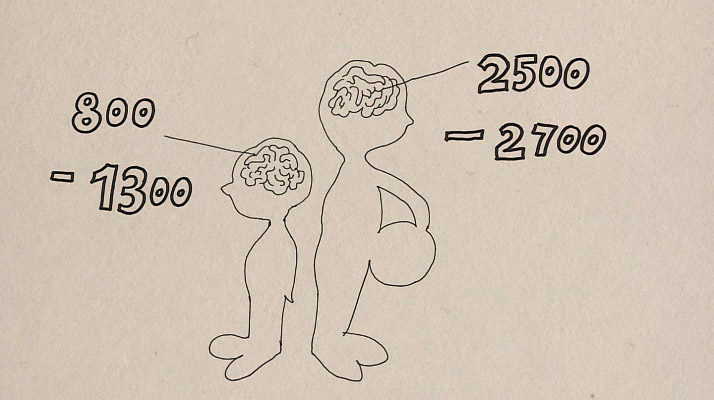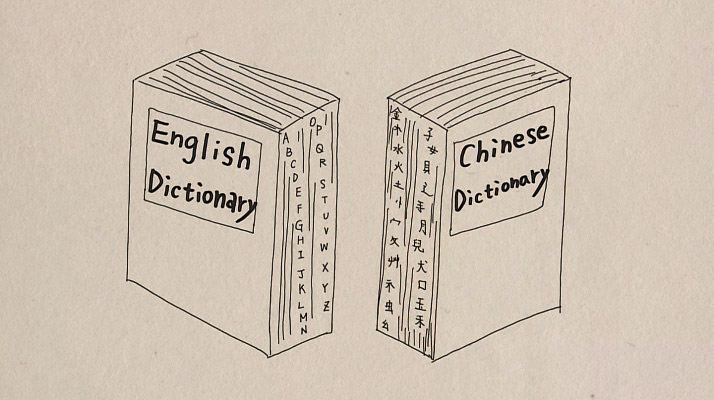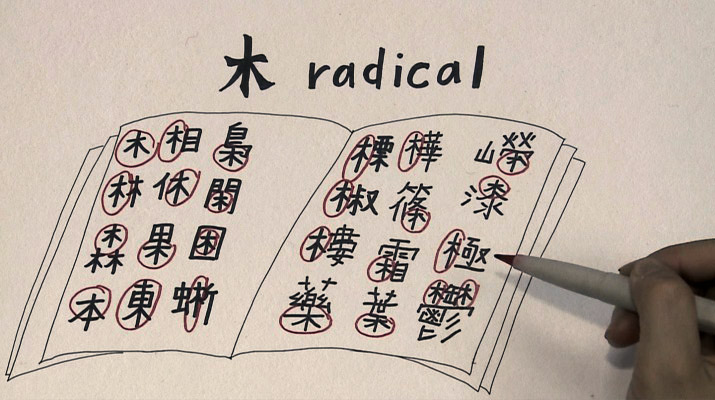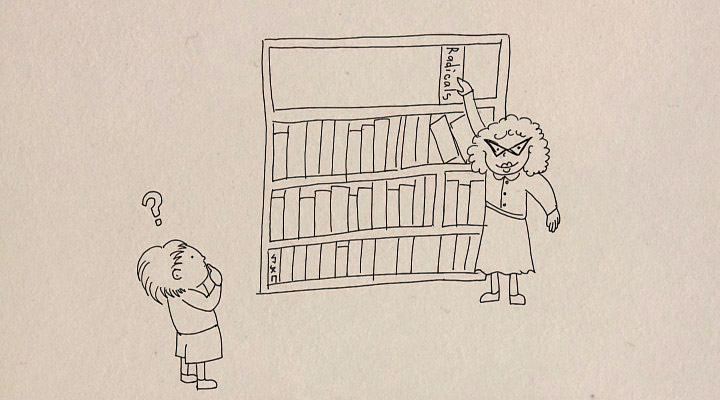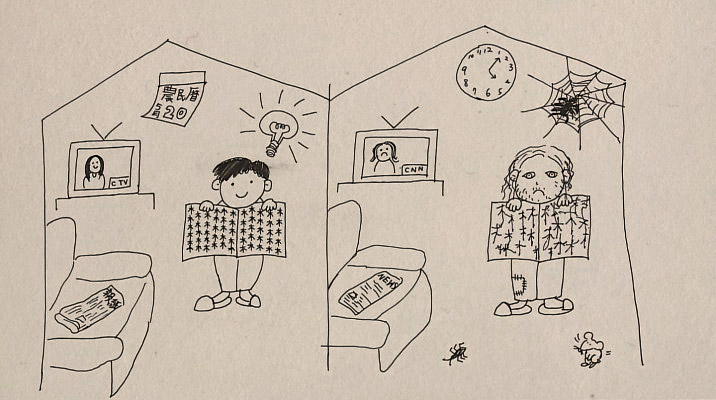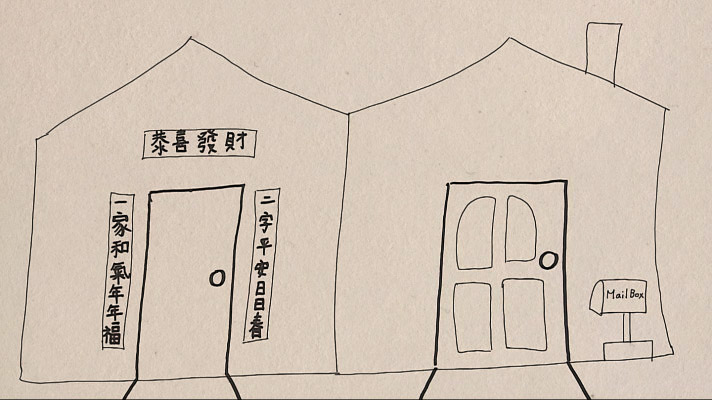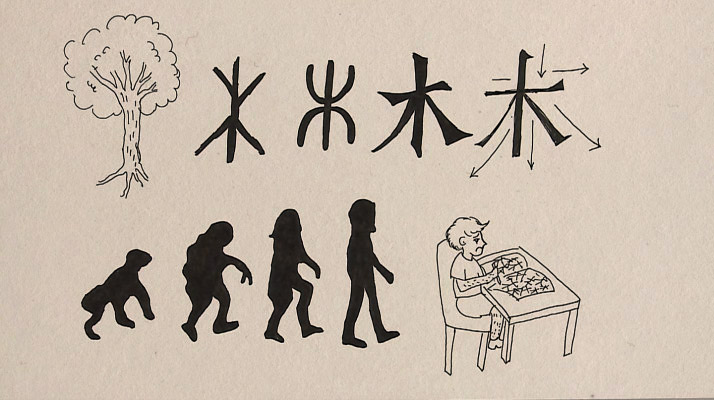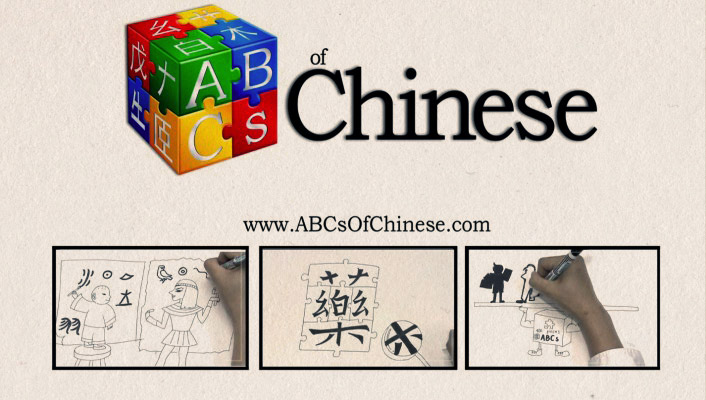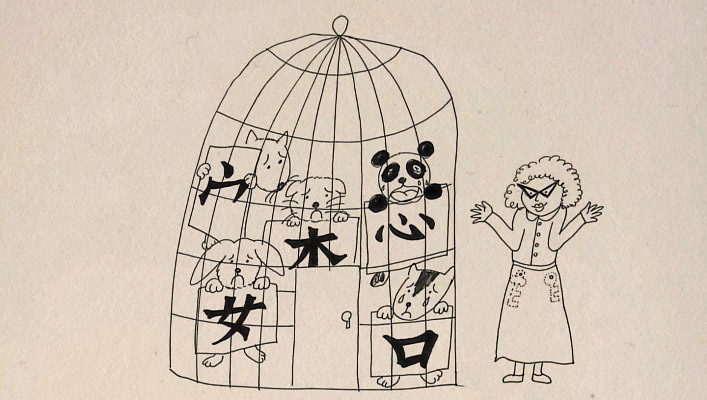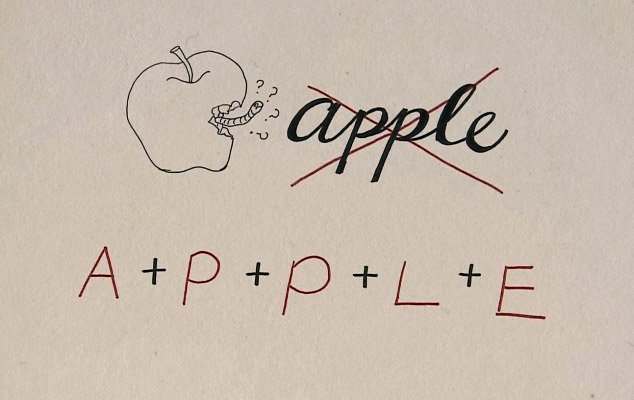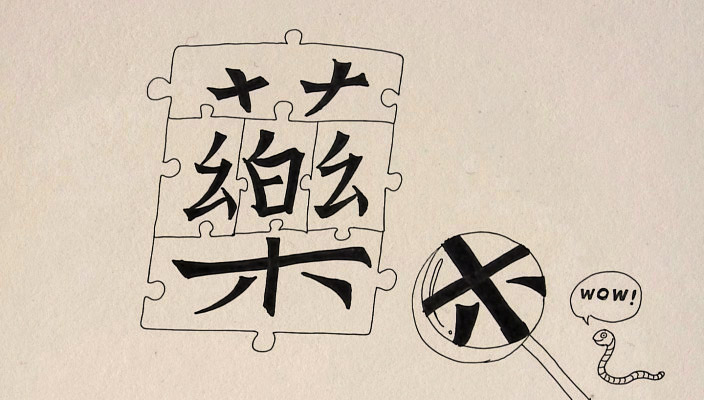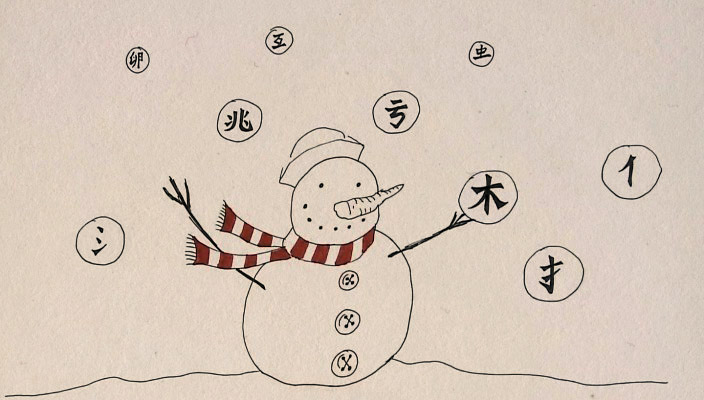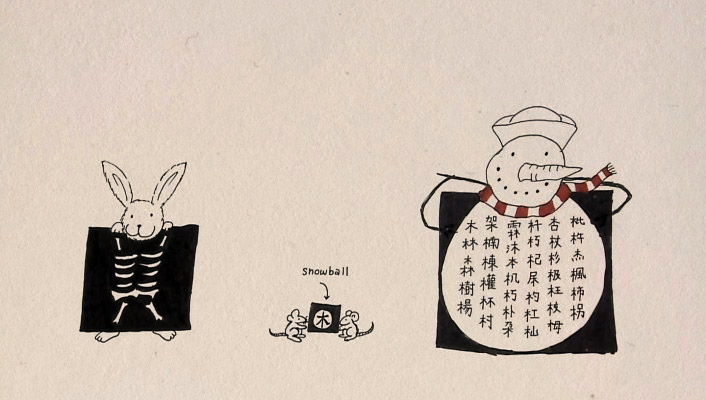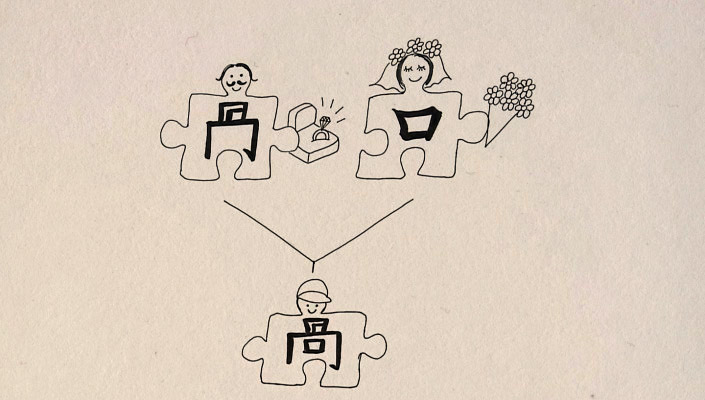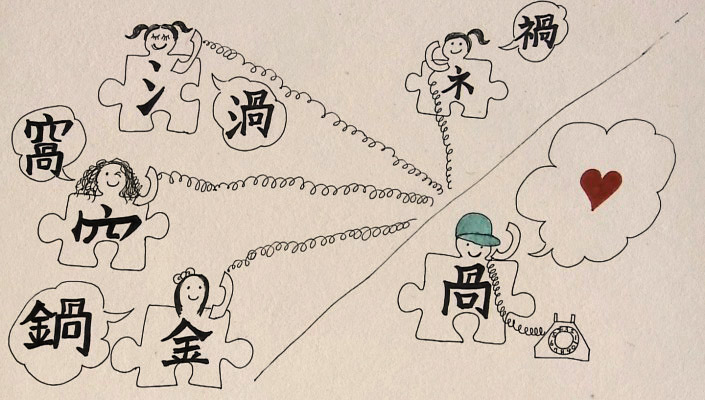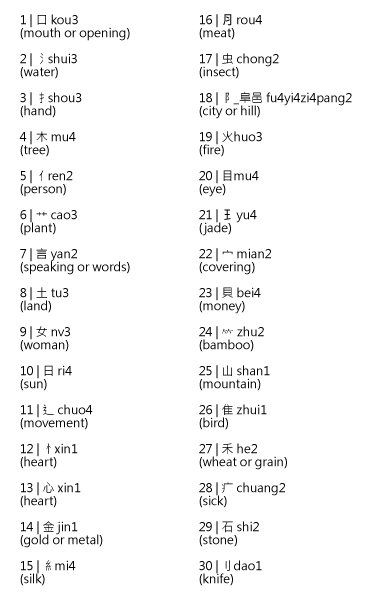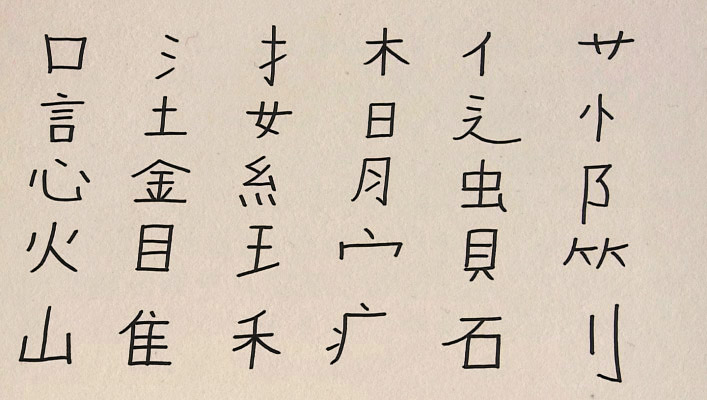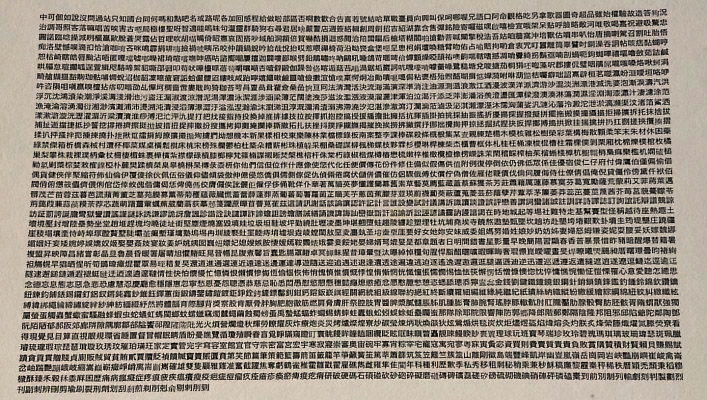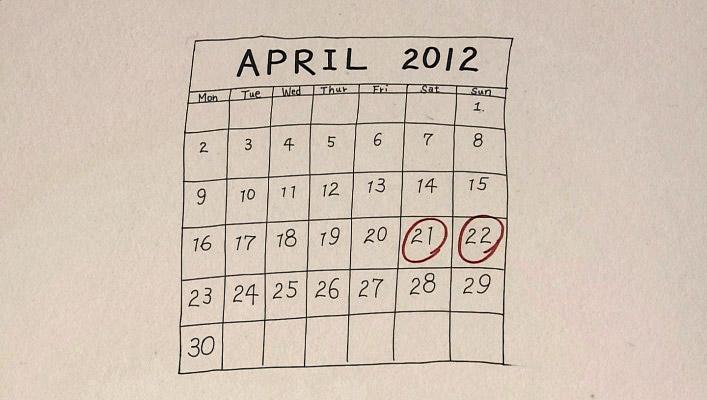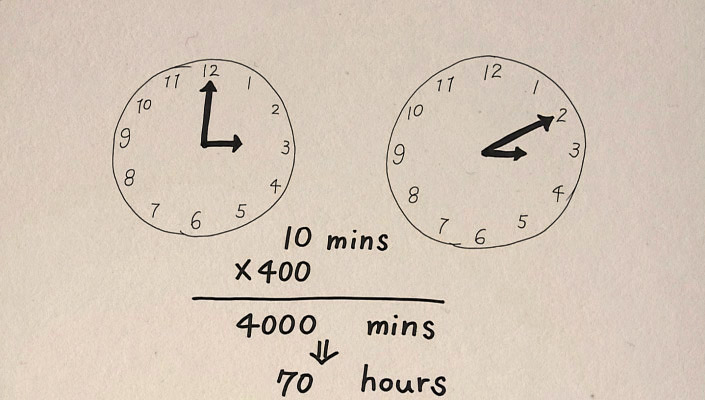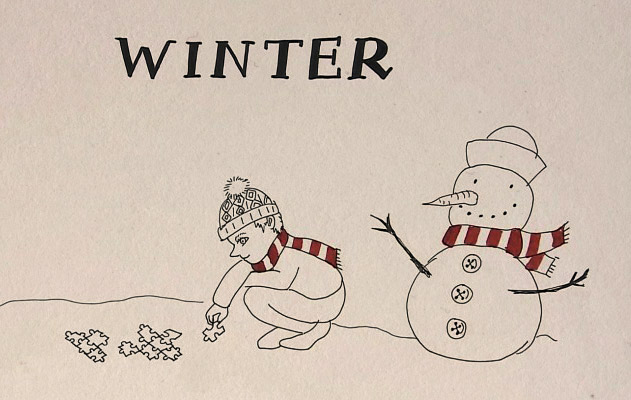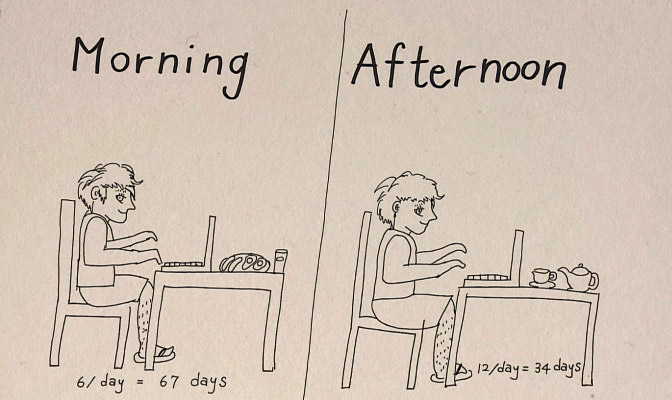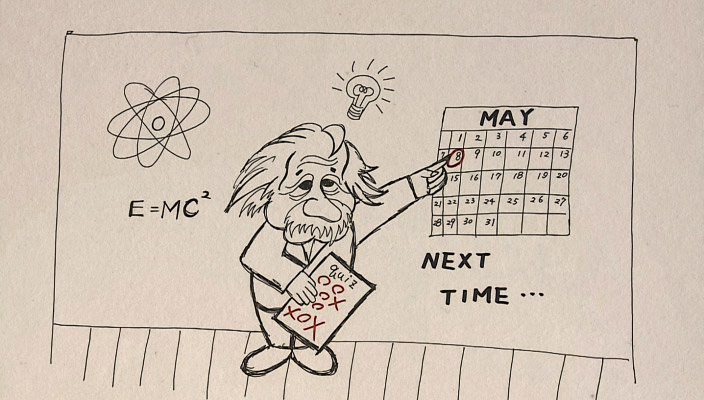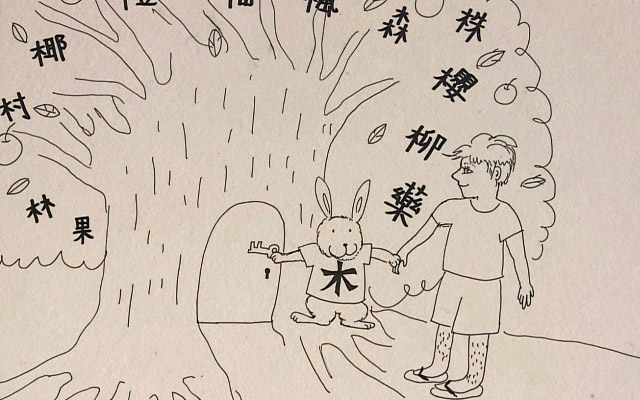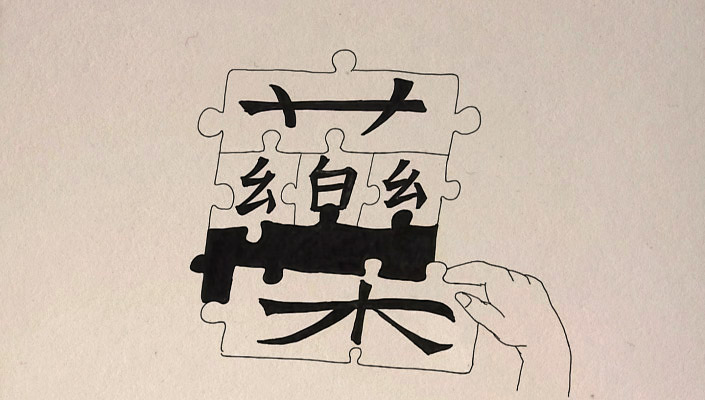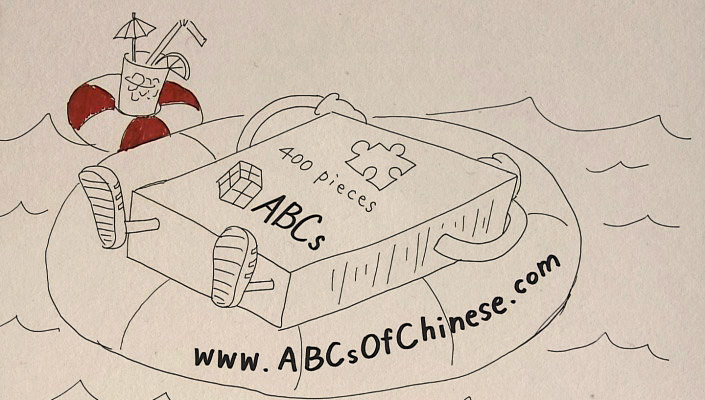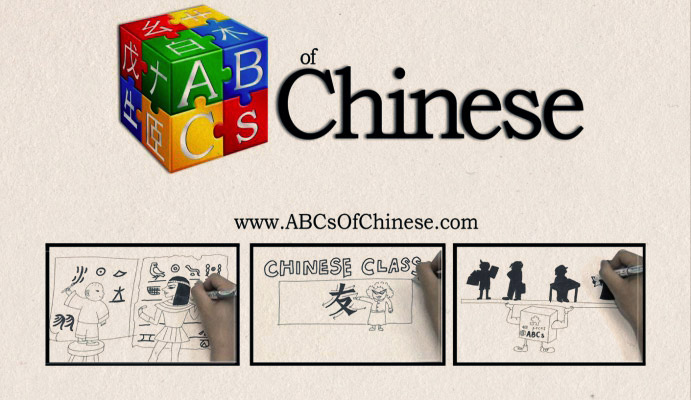TABLE OF CONTENTS MENU
Part 1: A Thorough Introduction to How Chinese Characters Work
1-1: Phonetic Languages 1-2: Pictographic Languages 1-3: Number of Chinese Characters 1-4: Conclusion
Part 2A: The Traditional Chinese Teaching Methodology
2A-1: Traditional Methods2A-2: Shortcomings of Traditional Methods
Part 2B: The ABCs of Chinese Teaching Methodology
2B: The ABCs of Chinese Approach
If you don’t feel up to reading, watch our informative videos instead!
1-1.Phonetic languages
Let’s talk about Chinese characters! They look tough and scary with all of their random lines, swoops and slashes… (“growl!”)….but they’re not actually as difficult as you think. They’re just very different from the phonetic alphabets that westerners are used to. With alphabets, letters act like “building blocks” that combine to form words. When you see the letter “T”, you know it represents the sound /t/. When you see the letters “T-R-E-E”, you recognize all of those sound symbols and you can put them together to form the sound “tree”. If you want to write the word “tree”, you think about how to say the word, pay attention to the sounds that you make, and then write down those letters. That’s how a phonetic writing system works. Chinese is much different though.
1-2. Pictographic languages
Chinese is a pictographic/ideographic writing system, not a phonetic writing system. Being a “pictographic/ideographic writing system” means that Chinese characters are pictures, like Egyptian hieroglyphs. So, when you want to write the word “tree” you don’t have to bother with writing letters so the reader can sound-out the word… You simply draw a picture of a tree (木). It’s that simple. That’s how a pictographic /ideographic writing system works! The Chinese writing system is based on drawings of the things they saw in the world around them. When you look at a Chinese character, you are looking at a stylized drawing that depicts an object or an idea. If a Chinese character is a picture of an object, like a tree, it’s called a “pictograph”. If a Chinese character is a picture of an abstract idea, like “three” or “happy”, it’s called an “ideograph”, which means “idea picture”. In laymen’s terms though, you can simply refer to the Chinese script as “Chinese characters.”
You are actually quite familiar with pictographs and ideographs; you see these types of symbols on a daily basis all around the world in the form of street signs and warning labels (like recycle, radioactive, wet floor, no swimming, no smoking, etc). These are examples of pictographic/ideographic symbols and they are universally understood because the human mind is excellent at pattern matching. When an eye sees a pattern, the brain has an innate drive to decipher the pattern as something it recognizes.
It’s easy enough to draw pictographs for simple objects such as a tree (木), fire (火) or a multi-floored tower (高) to express the idea “tall”. However attempting to draw abstract ideas like “have” or “may” as in “May I?” is a little more complicated. Consider for a moment what you would draw to capture the essence of “have/possess”. Perhaps you could draw a hand with something in it? That’s exactly what the Chinese ideograph portrays:it’s a simple, two-part picture that depicts a hand with an object in it (有). How about graphically illustrating the idea “may”? What could be drawn to represent this complex idea? The actual Chinese ideograph for this (可) is composed of two simpler pictographic parts: “obstacle” (ㄎ) and “opening” (口). By these two simpler pictures combining together they paint a picture that can be interpreted as “a way through an obstacle,” which is a very interesting way to think of getting permission.
Most Chinese characters work like the two examples above. Multiple simple pictographs are combined to convey increasingly complex objects and ideas. This approach makes sense, because there is a seemingly endless list of objects, ideas, situations, actions and descriptive words used in communication. It would be very difficult for *every* word to have its own *completely* unique symbol.
Just for fun, let’s look at a few more examples of how Chinese characters depict nouns, verbs, adjectives, adverbs, prepositions and conjunctions.
Nouns
[秋]“Autumn” is the season when grain stalks (禾) in the fields are burned (火).
Verbs
[看] The verb “see” depicts a hand (龵) shading an eye (目) as it gazes into the distance.
Adjectives
[貴]Shells were used as currency in ancient times. To make some purchases, an entire basket of shells (貝) was needed, so this is how the Chinese character for “expensive” is drawn.
Adverbs
[沒]To express “not”, the Chinese character shows a hand (又) reaching into swirling water (氵) searching for a lost object (⺇).
Prepositions
[至]The character for “to” shows a bird swooping down towards the ground (土), arriving “to” its destination.
Conjunctions
[須]The conjunction “must” reminds us of an ancient decree imposed on all men that required them to maintain long beards and hair (彡) on their heads (頁)
All of these simple pictographic/ideographic components fit together like puzzle pieces to create a “balanced”, visually pleasing Chinese character of uniform size. Some of these component parts are thin and tall, others are short and wide, and some bend. Depending on how many of these are combined, along with the shape of each component part, the following layouts are possible: 2 or 3 component parts might be stacked vertically, lined up next to each other horizontally, one component could encompass or partially encompass another, or any combination of these three. There are also rare instances where two components will merge together, as if one has been laid on top of the other. Additionally, some of these simple pictographic/ideographic components—but not all—are able to stand alone without combining with other components. For example, the component “heart” (心) is often combined with other components to help relay abstract meanings, however it also stands alone for the actual Chinese ideograph “heart”.
The pronunciation of the components is worth learning for they sometimes provide clues to the pronunciation of the character in which they occur. This means that even if it’s your first time to see a new Chinese character, you can probably guess what it means and also guess how to say the character if you recognize all of the smaller parts that are in the character! All of the components within a character contribute to its meaning,and about half of the time one of the components will carry the pronunciation of the entire character. However, this doesn’t occur consistently because the spoken language existed far before the written language.
When creating Chinese characters, drawing them to relay the meaning of the character took precedence over relaying their pronunciation. However, as the Chinese script has evolved through the centuries, scholars have occasionally added additional components to the original version of some characters in an attempt to clarify the character’s meaning or pronunciation. It should also be noted that due to the evolution of the spoken Chinese language, sometimes the character is no longer pronounced the way it once was, and thus the phonetic clue – if present at all – may not be completely accurate. The red component provides the character’s pronunciation.
1-3. Number of Chinese Characters
Alright, you get the idea of how Chinese characters work. Now let’s talk about numbers. People often ask how many Chinese characters there are. Different sources give different numbers. One of the most famous dictionaries in China, the Kangxi dictionary, contains just over 47,000 characters. The Taiwan Ministry of Education has been working to standardize traditional Chinese characters since the 1980s and to date they have published a total of 48,172 characters. The recently published Hanyu Da Cidian lists over 60,000 characters. If we look at computer encoding, due to the necessity to type Chinese characters, we find that Unicode 5.0 has approximately 70,000 Chinese characters in its tables. And lastly, the fifth official version of the Dictionary of Chinese Character Variants contains 106,230 characters.
The good news is you don’t really need to learn all of them. The Taiwan Ministry of Education has published a list of the 4,808 most frequently used traditional Chinese characters, followed by an additional 6,341 second-most frequently used traditional characters. In Hong Kong, the Education and Manpower Bureau established a list of 4,759 most frequently used traditional characters. And in Mainland China, the Chart of Common Characters of Modern Chinese only contains 3,500 in its list. The point is, these characters cover 99% of a two-million-word sample, which means that to be considered “literate”, one really only needs to recognize 3,500 simplified characters or 4,800 traditional characters. Phew!
1-4. Conclusion
So there you have it! Just by having reading this presentation you are already way ahead of the race because you understand that Chinese characters are much more than just a sequence of lines to be memorized. A Chinese character is a picture created by combining several simpler pictographic/ideographic components. These simpler pictographic/ideographic components are the “building blocks” of Chinese characters, just like alphabets are the building blocks of phonetic languages.
We hope you enjoyed this “pictographic” presentation! To learn how to use the intrinsic building block nature of Chinese characters to your advantage in order to quickly learn huge amounts of Chinese characters, read the next section “The ABCs of Chinese Teaching Methodology”. It will forever change your approach to learning Chinese characters! And if you’re just starting out or considering if you want to study Chinese or not, already living in Asia and functionally illiterate, studying Chinese in university be sure to read the 3rd segment, “The Importance of Learning Chinese”.
2A-1. Traditional Chinese Teaching Methodology
In the previous segment we discussed how Chinese characters work. In this section we will be explaining the traditional methodology used for teaching Chinese characters to both native speakers and foreign learners. We will then discuss the typical frustrations that arise from using this traditional approach and examine the cause of these frustrations. After that, we’ll let you in on a little secret that will show you how to quickly learn copious amounts of Chinese characters in a fun and interesting way!
When growing up in a native speaking environment, the student’s journey towards literacy begins in kindergarten. Before they start writing Chinese characters they are first taught phonetic symbols so they can write the pronunciation of Chinese characters. In Mainland China the students are taught the “pinyin” phonetic system, and it uses the Roman alphabetic symbols A-Z. In Taiwan, students use the“zhuyin” phonetic system, which are the traditional Chinese phonetic symbols. The “zhuyin” phonetic system is better known as “bopo mo fo”.
After learning the phonetic symbols, the student is immediately “thrown into the deep end” to begin learning whole Chinese characters. For the first week or so, the teacher will show the students how to write characters that have fewer strokes so that they can begin to learn the order of which lines to write first (this is called “stroke order”). The teacher will stand in front of the classroom and write a big Chinese character on the blackboard. The teacher counts every time one stroke is finished. As the teacher writes and counts, the students follow along with their fingers in the air.
After practicing this as a group for a few times, the students then write the character in their practice books 10 times or so. They will turn this in as homework and will be tested on the new character. If they make any mistakes on their homework or tests, they will have to do “punishment writing”, which will require them to write the character over and over again. The goal is to ensure that the student absolutely learns how to write the character and never forgets it. This teaching approach is called “rote memorization”. Before the little ones finish the first and second grades, they will have already memorized between 800 and 1300 complex characters! This is a very busy period in a 7-year olds’ life! By the time they finish the 6th grade, they will have already memorized 2500-2700 characters by rote—about two-thirds of the most frequently used characters.
2A-2. Chinese Dictionaries and Radicals
Also, at some point in the 5th or 6th grade the teacher will have introduced the concept of “radicals”. “Radicals” are more accurately translated as “dictionary section headers”. Now there’s obviously a need for a dictionary of Chinese characters, but it would have to work very differently from a western dictionary. In a western dictionary words are listed alphabetically, but since Chinese characters contain no letters to be organized by, this system wouldn’t work so well. This led to the creation of an interesting cataloging system that was based on the intrinsic “building block” nature of Chinese characters. If you haven’t read it yet, you should read the first section in this series: “A Thorough Introduction to How Chinese Characters Work”. As you recall from there, most characters are formed by combining several simpler pictographs/ideographs. This “radical” cataloging system organizes Chinese characters in the dictionary based on the smaller parts that they contain.
Every Chinese character is classified under one “radical section header” in the dictionary. For example, there is a section header for (木) “tree” and *most* Chinese characters that contain this pictograph can be found under this section header in a dictionary. Thus, if you encounter an unfamiliar Chinese character but you are able to recognize the “tree” radical within the unfamiliar character, you could go to the “tree” section of a Chinese dictionary to locate the unfamiliar character. Then you could learn how to pronounce the character and also learn its meaning.
So as I was saying, when you’re an older elementary school student who has already learned many characters that contain the radical (木) “tree”, the teacher would point out, “See, this part is ‘tree’ and it’s a radical.” This isn’t taught to students too early because it’s assumed it would overwhelm the young student—they don’t need to know what section header the characters they are learning are classified under in a dictionary. All they need to do is memorize how to write the whole character correctly along with its pronunciation. All emphasis is strictly placed on learning how to read and write the characters they will need in their daily lives.
2A-3. Shortcomings of the Traditional Methodology
Foreign learners of Chinese are taught Chinese characters in pretty much the same way as first and second graders. The difference is that very little time is spent in class on writing. Instead most students have a “character practice” book where they can trace Chinese characters to learn the correct stroke order. It’s a self-study endeavor wherein the student copies the stroke-by-stroke, line-swoop-slash illustrations presented in the workbook and then practice writing it freehand in the provided empty spaces. This is turned in for homework, and of course there are always quizzes on the new characters.
Just like beginner-level native students, foreign students aren’t told about radicals or character composition. The goal is purely to get the student to quickly recognize a few words for use in daily life via rote memorization. The student’s job is to memorize the correct sequence of lines and try not to mix up characters. This can be pretty confusing in the beginning, especially for characters with lots of strokes. It’s easy to accidentally add an extra line or two, and just as easy to forget to write part of the character.
Using rote memorization to learn Chinese characters is an effective method to ensure that the student never forgets how to recognize or write a character. It has proven to work quite successfully for over one-billion people. However, any person with experience studying Chinese in this way, both native speakers and foreign learners alike, can attest that it is a dreaded and monotonous chore. Most foreign learners would also add “stressful” and “frustrating”. This is because characters are taught as whole pieces with emphasis placed on writing thousands of meaningless lines in the correct sequence. Now this approach has worked for one-billion native speaking people who spend their entire lives immersed in a Chinese speaking culture and see Chinese characters on a daily basis, but a foreign learner of Chinese is coming from a very different situation and with a very different mindset.
After reading the previous segment “A Thorough Introduction to How Chinese Characters Work”, you understand that a Chinese character is much more than just a sequence of lines. A Chinese character is a picture created by combining several simpler pictographic/ideographic components. Every single Chinese character portrays a fascinating story, but teachers don’t tell their students this. With the current teaching method, these beautiful and interesting characters have been reduced to a soulless sequence of lines to be memorized and written over and over again. Doing this takes away all of the fun, mystery and 4000 years of history.
Part 2B—The ABCs of Chinese Teaching Methodolgy:
As you can see, with the traditional teaching methodology students are typically NOT taught that Chinese characters are a combination of simpler pictographic/ideographic components. However, at the ABCs of Chinese we have designed our entire writing curriculum around the fact that a westerner’s mind is hardwired to see “building blocks”. We have focused on the intrinsic building block nature of Chinese characters and systematized a process so that a student can first learn the easy-to-remember “pieces” of Chinese characters. By doing this, a Chinese character will no longer be a dreaded thing with 15 lines to remember. Instead it will become a combination of 3 simpler pictures you are already very familiar with! No one could disagree that you should obviously first learn your ABCs before you start reading and writing whole English words. The same principle applies here: learn the basic building blocks of Chinese characters before you start learning whole Chinese characters. It is the combination of these simpler pictographic/ideographic building blocks that gives a Chinese character its meaning and pronunciation.
Our writing curriculum is the culmination of hundreds of hours of research spent to break-down over 100,000 Chinese characters into their most basic components and then from there decode and cross-reference these components to confirm their original meanings. This process resulted in isolating 400 simple pictographic/ideographic components as the basic building blocks of all Chinese characters. Only 400 basic building block components! The implications of this are massive because 400 pictographic/ideographic components is FAR less than what could first be perceived as 100,000 totally unconnected characters.
We guarantee that every Chinese character you will learn contains these basic components. They appear over and over again in different combinations to form all 100,000 Chinese characters. Some of these basic components are standard radicals, and some are other pictographic/ideographic components. In addition, most of these pictographic/ideographic components are actually stand-alone Chinese characters by themselves, so even if you were to learn whole Chinese characters by rote memorization you would still have to learn them anyway!
If you can change your perspective to see that a Chinese character isn’t a crazy behemoth of lines, swoops and slashes, but rather a combination of several simpler pictographic/ideographic components that you’re already very familiar with, then a character is no longer intimidating at all. And by knowing these pieces your rate of learning will go through the roof!
The ABCs of Chinese writing curriculum snowballs. You start out by learning the foundational components that form Chinese characters rather than immediately beginning to learn whole Chinese characters. However, no time will be lost in doing this. In our writing curriculum you will learn the most frequently used components first, and the less frequently seen ones later. As you progress through the curriculum you will see that the components you have already learned are repeated over and over in combination with new components you learn, which constantly reinforces those you have already learned. We do this in order to get you to your goal as quickly as possible—being able to read and write thousands of Chinese characters. As you learn these pictographic/ideographic components you will quickly reach a critical mass where suddenly all the pieces fall into place and you will begin to learn whole characters exponentially fast.
Additionally, once you start learning whole Chinese characters, you will see that similar to how basic components combine with other basic components to make Chinese characters, some Chinese characters also combine to make more complex characters. Take for example “guo1” (咼), a simple Chinese character formed from the components skull (冎) and mouth (口). This Chinese character helps make lots of other characters by merely attaching different components. We call these very helpful little characters“key characters”, and we’ll teach you these characters early on to help you learn as many Chinese characters in the fastest and most effective manner possible!
Let me take a few minutes to illustrate the ABCs of Chinese approach to learning Chinese characters so you can see exactly how digestible this curriculum is. Remember how we said there are a total of 400 simple pictographs? Here are the 30 most commonly used to form Chinese characters:
These 30 basic components combine with each other to form nearly 180 different Chinese characters. That means just by knowing these 30 basic components, you will be able to write 180 different characters! Go ahead and pause here to take a closer look and see that these Chinese characters aren’t just a collection of random lines. They are all composed of the same 30 basic parts.
Aside from these 180 characters, these 30 simple components also appear in over 2,500 other Chinese characters! So by knowing them, you will be one step closer to being able to read and write over 2,500 characters!
Learning 30 components is learning one a day for a month… or 2 days worth of work if you’re really motivated! Allow me to carry out the math for you. On average, it will take you 10 minutes to finish all of the exercises to learn a component. This is factoring in that the exercises will take you longer in the beginning while you’re getting used to working with a pictographic/ideographic writing system, but you’ll complete the exercises much faster as you progress. So that’s 10 minutes a level, multiplied by 400 levels, equals 4000 minutes, which is approximately 70 hours. 70 hours of hands on time is not much time at all.
If you’re currently living in Asia and have a busy schedule, in the beginning maybe you’ll only spend ten minutes to learn one component a day. But we suspect that very quickly the more you learn, the more you will want to learn, especially once you start noticing the components on the street that you have been learning! Once you realize the benefit, you very well might start doubling up or tripling up and spending 20-30 minutes to learn two or three a day. Going at this rate, you’re looking at about 180 days—6 months.
If you’re an ambitious student who is serious about learning lots of Chinese characters in a hurry, all the power to you! Are you willing to commit an hour to learn 6 components a day? At this rate it will only take you 67 days– Just over 2 months. Can you do an hour in the morning and another hour in the afternoon? If you can commit to learning 12 basic components a day, you will learn all 400 in 34 days and then you will be ready to tear through Chinese characters!
There’s one last thing to mention: you don’t need to worry about forgetting any of the components you learn early on as you continue to learn more and more components. Every component you learn will be queued into your personalized “Review Quiz”. The engine of your Review Quiz runs on memory-optimizing, spaced repetition algorithms. These algorithms are designed to keep the basic components and characters fresh in your mind and also to schedule your reviews efficiently so that you don’t waste unnecessary time reviewing components that you already know well.
The Review Quizzes work like this: you will be given a super fast review quiz 8 hours after you learn a component. You will have to take this quiz before you can continue to learn any new components. After taking the quiz, you must grade yourself on it. You will be given the following choices:
I forgot
I made a mistake
Correct but slow
Very easy
The way you grade yourself will determine how much time will lapse until your next review of the current component. For example, if you forgot, you will immediately be quizzed on it again at the end of your quiz, and in addition you will be quizzed on it again the following day. If you selected “Very easy!”, your next quiz won’t be scheduled for several days. Over time, after you have been quizzed on a component several times, the algorithm learns which components you tend to struggle with and which ones you consistently have very strong retention of. Those components that you struggle with will appear in your review quizzes more frequently, and components that you consistently grade as “Very Easy” will be seen very rarely. We take care of scheduling all the periodic reviews for you to ensure you see the components often enough to burn them into your long-term memory, but not more often than necessary!
We’ve worked hard to make the writing curriculum at the ABCs of Chinese as motivating, entertaining and game-like as possible. Each component is its own level, and in each level there are several fun exercises that guarantee you will learn the component. On average it will take you 10 minutes to finish a level—and by “finish a level”we mean, “really learn a pictographic/ideographic component”. You will learn how to say it, how to write it correctly, how to immediately spot it in a Chinese character and also see how it combines with other basic components to lend its meaning and pronunciation.
As you successfully complete each level, you will “discover” every Chinese character the basic component appears in. Then, once you have learned all of the components that form a particular Chinese character, that character will be “unlocked” for you to learn. Also, you’re earning points and trophies along the way AND you can track your friends’ and fellow students’ progress.
Are you ready to give the ABCs of Chinese writing curriculum a try?! Click the “Create a free trial account” button at www.abcsofchinese.com see exactly how our writing curriculum works!
